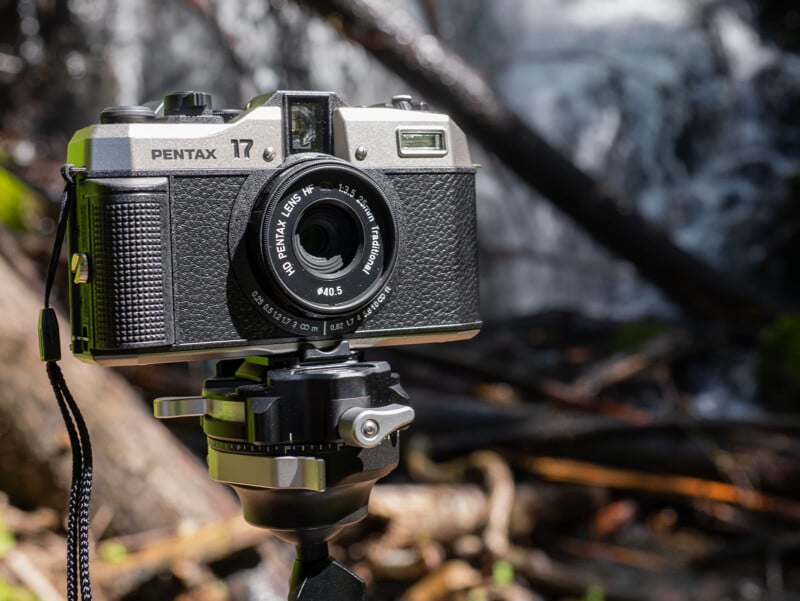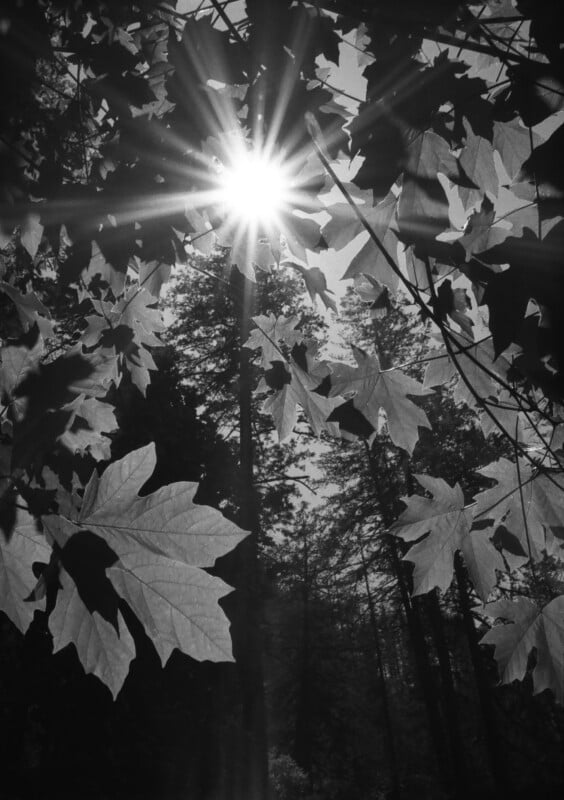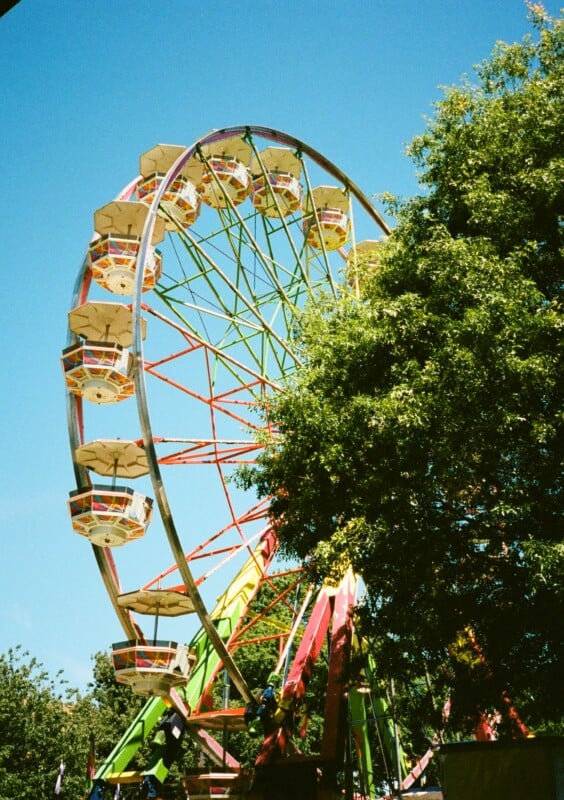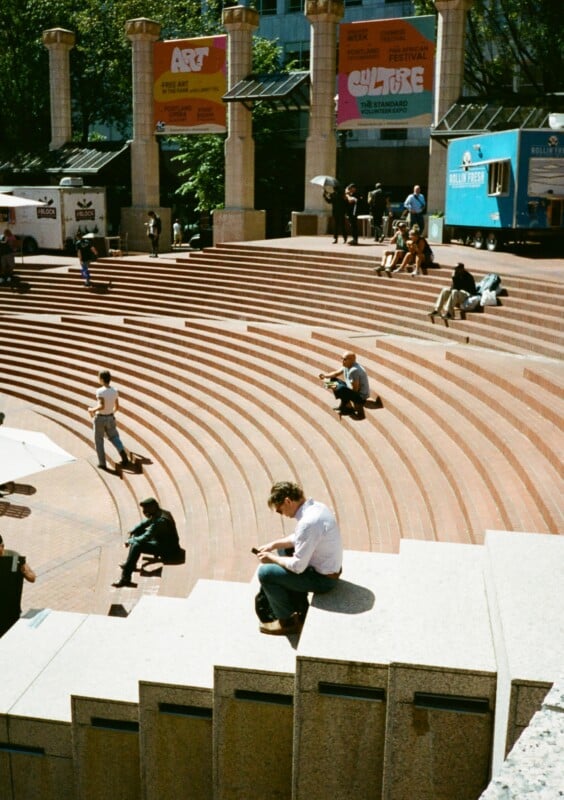Pentax 17 Review: A Brand-New Film Experience Worth Having
I’ve been in the camera review business for over 15 years and in that time I’ve been fortunate enough to have tested and taken photographs with countless cameras, spanning a wide variety of designs and intentions. Curiously, as I prepared to review the Pentax 17 it occurred to me that I had never once reviewed a new production 35mm film camera in all that time.
Partly, this is due to the now-reborn analog market being supported by a healthy surplus of used 35mm film cameras and, of course, I have used plenty of film cameras in our previous videos to test a new film emulsion or as part of a photographic experiment. But the time is right for a new film camera as analog photography doesn’t seem to be slowing down.

The industry has indeed seen a rush of new analog film emulsions and a huge resurgence in the instant film market too, but the Pentax 17 represents the first new production 35mm film camera from one of the major brands in nearly 20 years.


In a time where it seems Canon and Nikon have long since let go of their storied film cameras, Pentax is dedicated to keeping not only the DSLR alive, but also a part of the analog film market, too. Whether the Pentax 17 will find a hold in new photographers’ hearts is admittedly a gamble but it is a brave toss of the dice and the camera itself has some serious charm.


A Gorgeous Camera That Harkens Back to Pentax’s Glory Days
The first thing that grabs anyone who sees and holds the Pentax 17 for the first time is its striking design and titanium-colored finish. Pentax asked one of its veteran designers by the name of Suzuki Takeo, AKA TKO, to create an analog experience that borrows elements from multiple classic cameras. Everything from the flash, lens, shutter buttons, and dials, are inspired by cameras like the Pentax LX, KP, and AUTO 110, just to name a few.

The viewfinder is particularly beautiful to look through and is oriented vertically with fairly bright frame lines for both distant and up-close parallax-corrected situations. Why a vertical setup? The Pentax 17 is a half-frame 35mm film camera where frames are shot vertically to be 17mm wide — hence the namesake — and 24mm tall, as opposed to full-frame 35mm which is 36mm by 24mm.

I only had time to shoot two rolls of film during my time with the Pentax 17 and was impressed by how many keepers I had and how accurately the frame lines composed my final images. Even up close, the frame lines were quite accurate.



Pentax intends for half-frame to be useful not only to cut analog costs in half by doing this but also to provide an easier transition for smartphone photographers who are already familiar with shooting predominantly vertical shots. On the cost front, analog photography is pricey — not only for film costs but developing costs as well — and being able to get twice as many images per roll is a boon.
Most commercial film developing nowadays is going to automatically scan your shots into JPEGs (the ones we received were 2,905 by 2,048 pixels each) and thus it’s easy and natural to share said vertical images directly onto social media and capture the natural analog look in your images. You can certainly turn the camera sideways and do as many horizontal shots as your heart desires, too. I found the Pentax 17 to be perfectly comfortable to use when shooting horizontal frames.


Pentax 17: Toy Camera, Serious Camera, Or Something in Between?
The Pentax 17 isn’t just a camera that takes analog images with the press of a single button like a pocket point-and-shoot would. It is chiefly intended to be a tactile hands-on experience and a big part of the fun of this camera is its thumb winder mechanism.

Rewinding, loading, and advancing the film is all an authentic and enjoyable experience and I’m glad Pentax decided to go strictly manual with this process. The thumb winder also naturally provides a place for your thumb to lock into while holding the camera and this is further facilitated by a generous grip which also houses the disposable lithium CR2 battery that powers the camera.


This camera also shows a stark duality between some strictly manual controls like the lens focusing and film speed dials but also a very automatic way of exposing and shooting photos. The leaf-shutter inside the camera gives a range of shutter speeds from four seconds — or you can also use a Bulb setting — to 1/350 second. It is hardly a wide range of shutter speed choices and the Pentax 17 is lacking any manual input from the user, save for Bulb mode.
The lens is a 25mm f/3.5 and that closes down to f/16 as a maximum. The lens shows a full-frame equivalent field of view that a 37mm lens would provide. Again, there is no real control over the aperture on this camera except the option to force f/3.5 when desired.


The camera itself is extremely lightweight coming just under 300 grams even though it has a magnesium top and bottom plate. The general build quality of the camera is better than I expected overall with the dials and knobs being easy to adjust and fairly positive when clicking into place. However, I will say that some parts of the camera feel a little plasticky -chiefly the lens housing area- so this camera feels neither like a toy, nor a premium and prestigious tool. There is no weather sealing to speak of and I would certainly say that the Pentax 17 seems better suited to fair weather days around town rather than out on the trail in the dirt and grime.

Focusing the lens is done by zones as opposed to any precise manual focusing. You determine the rough distance to your subject, set the camera to the appropriate zone, and hope for the best. I have to admit, I was quite skeptical upon hearing that the camera zone focuses. Usually, the accuracy of such a system is dubious at best. However, the Pentax 17 actually works quite well and I find that in most situations there is enough depth-of-field to cover any shift.
You get a zone to cover infinity, roughly 10 feet away, a 5.5-foot setting, and a four-foot setting. I found the implementation quite easy to use as long as I formed a routine of checking it regularly. You could get carried away with the excitement of taking photos and forget to change zones, only to find some shots out of focus, though. That said, I did use the closer settings for portraits and found even with shallower focus the camera was on target.

There are two close-up specific zones which are for set to 1.7 feet which is intended for things like food pictures and a macro setting at 0.82 feet which is still not macro by any stretch. You could experiment with close-up filters to get even closer but the framing and distance would become a guessing game. Regardless, I was expecting to have so many shots out of focus and instead was pleasantly surprised. Using a 400 ISO film outdoors will certainly help the camera to use tighter apertures anyway and cover most focusing ranges. It’s also important to point out that even when you choose a zone of focus the Pentax 17 does adjust the focusing of the lens separately to accommodate the aperture that the light meter chooses and maximize the depth-of-field for that area of focus.

How Far Can You Push the Pentax 17?
There is a manual ISO dial without any automatic DX film speed option so you do have to be diligent about setting this to the speed you want to expose your film for. Next to that is a compact but usable exposure compensation dial that goes up to two stops above or below the light meter’s recommendation. Due to the limited range of shutter speeds, the ISO of the film you buy will be important to your experience.
For example, ISO 400 film worked great outdoors but would often force the camera to use very tight apertures, which is very forgiving to imprecise focusing but gives no sort of shallow depth-of-field or soft-looking backgrounds. Conversely, ISO 100 film is a great choice for most situations but the Pentax 17 does not give you any indication of what aperture or shutter speed you are using and if your shutter speed drops too slow, you’ll only know about it when your photos come back blurry. The Pentax will blink a light at you in the viewfinder to warn you that the lighting is dark but more experienced photographers might be wanting for a little more detailed information.



Exposure adjustment on this camera is designed to be a largely automatic process and it’s important to state that anyone seeking manual controls and a more precise experience will be disappointed here. I pushed the camera as far as I could to manipulate exposure and I will say that you can’t push it far at all. The light meter is based on a partially center-weighted averaging metering and therefore does a good job when light levels are even across the frame. It will struggle the same way that a vintage manual film camera will when it comes to predominantly light or dark-toned scenes as well as compositions containing bright light sources towards the camera. New users to the analog experience may have to put in some effort to learn how to predict when the meter will struggle and apply the right amount of exposure compensation. For certain scenes where I wanted to guarantee a good exposure, I would bracket my shots and even use a digital camera to preview the exposure before committing to film. There are various apps that will utilize your phone as a light meter and these can be helpful too.
When it comes to the mode dial, we are stuck with predominantly a Program setting way of shooting. The white-paint zone of the dial gives you Program mode where the camera will set the aperture and shutter speed for you. There is also a Bokeh setting which forces the camera to use f/3.5 only but be wary of using this setting in bright light with faster speed film or you will get overexposure. There is also a Bulb mode where the shutter will stay open as long as you hold down the button or cable release. I used this for my waterfall long exposures alongside some strong ND filters and it worked very well in conjunction with a light meter app.


There is also a gold-colored area on the mode dial which gives you access to a second Program mode but with the option to have the camera automatically fire the flash if it deems it necessary. There is also the option to force the flash to fire every time which could be handy to fill in shadows on close subjects or for dark interior situations. The flash itself though is quite low power and the lack of directionality will tend to give very harsh-looking light. Lastly, there is a full Auto mode which basically does what the gold program mode does but locks you out of the two closest focusing zones and sets the camera to largely make everything from roughly four feet to infinity in focus. This gives you the most point-and-shoot experience if you just want to shoot and see what happens.


The Pentax 17 Makes Photography Fun
Look, the image quality on the Pentax 17 is more about having fun, experimenting a bit, accepting the occasional bad exposure, and taking some pleasure in the analog experience. There is no denying that the half-frame images will be grainy and often a little washed out or a little too dark, although the lens is capable of some good sharpness. However, I also can’t deny that the Pentax 17 exactly captures the fun that many of us felt when we started on vintage film cameras. The tactile experience of using the thumb winder and loading film manually, the path to learning how to expose a more basic film camera, and the hard-fought fought-experience that comes with getting a great shot after fighting with an occasional bad picture are all here.
The Pentax 17 also makes images that have an inherent charm and a look that is both engaging and very different from what most of us are used to with digital cameras. There is the anticipation of seeing what your image results will be and the pleasure that can be found in simply shooting for the sake of having fun and letting go of the hang-ups that come with trying to get “perfect” shots all the time.
What the Pentax 17 does so well is give first-time film users the genuine experience of using a classic film camera and at the same time also give a seasoned film photographer that feeling of joy that they may have misplaced along the way.
Are There Alternatives?
The sort answer is no. Of course, the used market will be another main source of analog equipment but the $500 Pentax 17 represents a unique shooting experience and gives the peace of mind that comes with a brand-new purchase. Half-frame cameras are also relatively rare, so the Pentax 17 fills a needed void.
Should You Buy It?
Yes. If you are looking to get into your first analog experience, the Pentax 17 offers the fun factor, and the opportunity to learn the ropes, all in a stylish and functional camera.



